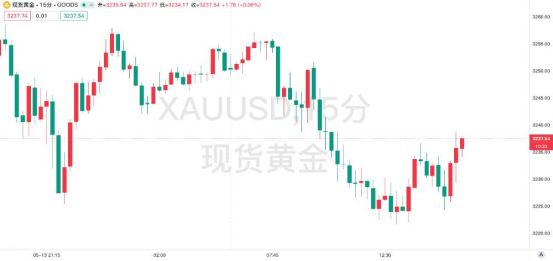US April CPI is lower than expected! Expectations of a Fed rate cut soar, can gold bulls take advantage of the momentum?
- 2025年5月15日
- Posted by: Macro Global Markets
- Category: News

The U.S. CPI data for April was unexpectedly lower than expected, triggering strong market expectations of a shift in the Federal Reserve's monetary policy. Data showed that CPI rose 2.3% year-on-year in April, the lowest since February 2021, and the core CPI rose 2.8% year-on-year, in line with expectations. Affected by this, the market is betting that the Federal Reserve may launch its first interest rate cut this year in September, with a total rate cut of about 56 basis points for the whole year.

Data released by the U.S. Bureau of Labor Statistics on May 13 showed that CPI rose 0.2% month-on-month in April, lower than the expected 0.3%. The year-on-year growth rate fell further from 2.4% in March to 2.3%, a four-year low. The core CPI (excluding food and energy) rose 0.2% month-on-month and remained unchanged at 2.8% year-on-year, in line with market expectations. This data has dispelled the market's previous concerns about "sticky inflation", especially the sharp drop in food prices has become a key driving force - egg prices plummeted 13% in a single month, the biggest drop in 40 years, and the prices of bacon, chicken and other products also fell, lowering the overall inflation level.
Although housing costs rose 0.3% month-on-month and energy prices rose 0.7%, indicating that structural pressures still exist, the weakness of the overall data has significantly increased market expectations for a rate cut by the Federal Reserve. Interest rate swap contracts show that traders are now betting that the Federal Reserve will initiate its first rate cut in September, with a total rate cut of about 56 basis points for the whole year, a sharp drop from 75 basis points last week, but the timing of the first rate cut has been brought forward from December to September. TD Securities predicts that there could be five rate cuts by 2025, arguing that slowing economic growth will force the Federal Reserve to adopt an easing policy.
2. Fed policy game: uncertainty in the rate cut path and market reaction
Federal Reserve officials have recently expressed caution in their statements. On May 12, Federal Reserve Board Governor Kugler pointed out that the Trump administration's tariff policy may push up inflation and drag down economic growth. Even after the Sino-US trade tensions ease, we still need to be wary of the lag effect of policy transmission. In a speech late at night on May 14, Federal Reserve Chairman Powell stressed that the Fed needs to remain patient and maintain high interest rates to ensure that inflation continues to cool, but made it clear that the next move is unlikely to be a rate hike. Although this statement did not directly mention interest rate cuts, it sent a signal of a policy shift, further consolidating market expectations for a rate cut in September.
Affected by this, the US dollar index plunged to 101.40 in the short term after the data was released, and then rebounded to 101.54, and finally closed at 100.9251, down 0.0544%. The 10-year U.S. Treasury yield fell back to 4.429%, down a few basis points from before the data was released, reflecting the market's weakening expectations of continued inflationary pressures. In terms of U.S. stocks, the Nasdaq index rose 1.61% and the S&P 500 index rose 0.72%. Risk assets responded significantly positively to expectations of rate cuts.
三、黃金市場機遇:降息預期與地緣風險的雙重驅動
Weak inflation data and rising expectations of interest rate cuts have injected a shot in the arm for the gold market. In the early Asian session on May 14, spot gold rose to a recent high of 3257.81. But after today's opening, it fell to around 3226 and fluctuated, and then retreated in the short term, rising by US$10 to around US$3237.37.

Unexpectedly weak inflation data and a shift in Federal Reserve policy expectations have put the gold market at a critical turning point. The dual drivers of interest rate cut expectations and geopolitical risks provide support for gold prices, but policy uncertainty and repeated inflation risks still need to be vigilant. Investors need to pay close attention to subsequent data and events and seize opportunities in market fluctuations.
